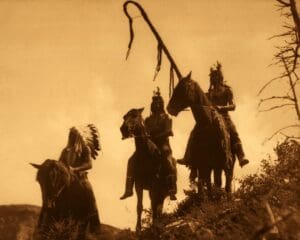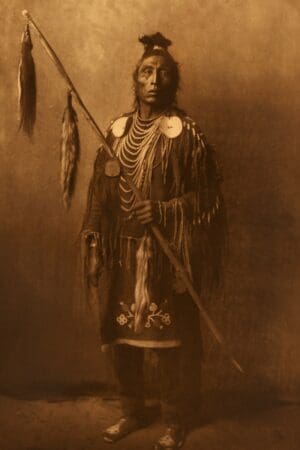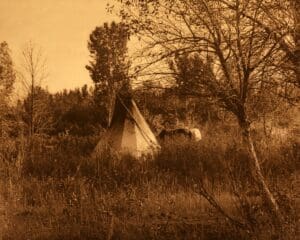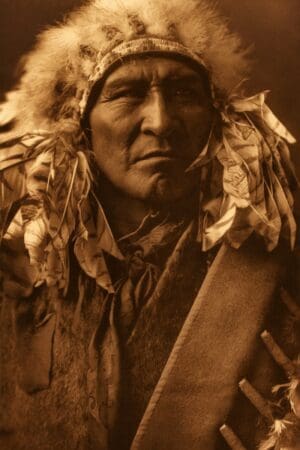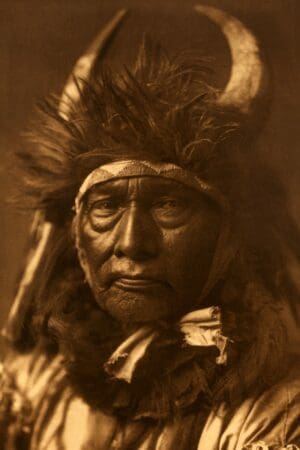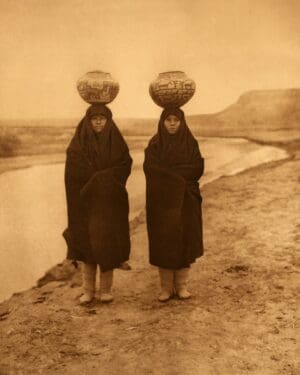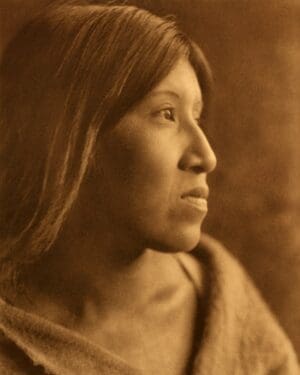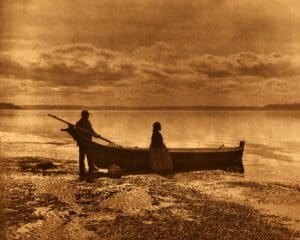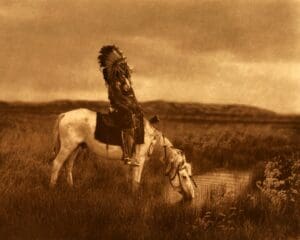Crow Native Americans
Crow Indians by Edward S. Curtis
Tribal Summary
Dress
Crow Men wore the usual fringed leggings and shirt of deerskin or antelope-skin, moccasins of the skin of elk,deer, antelope, or buffalo. The robe was the skin of a young buffalo cow, worn with the head over the left shoulder and with the hairy side inward. A band of quills or of beads extended throughout its length. The loin-cloth was not used previous to about the year 1830. Winter moccasins for both sexes were of buffalo-skin, with hair inside, and men wore caps of the same material. After the advent of traders it was common to wear a long overcoat made of white or yellow-striped woolen blankets, with hood attached – a garment fashioned by the women. The banged forelock and the hair at the sides, cut square but not short, were curled upward by means of a heated stick. At the back the hair, greatly lengthened by splicing to it the hair cut from the head of a person in mourning, hung in numerous thin twists, to which were stuck little beads of spruce gum colored with a reddish paint. At each side was tied near the head a small ring of varicolored porcupine-quills. Both sexes perfumed the hair with sweet-smelling herbs and with castor, and rubbed it glossy with cactus pith. About 1830 the men began to dress the hair in imitation of the Nez Perces: two braids at the sides in front of the shoulders and a braid behind, each wrapped with strips of fur, and the forelock thrown back in a thick pompadour. Tattooing was not general, but some men had a symbol of their medicine pricked in their breast. In tattooing, four or five porcupine-quills, held with the points almost touching, were pricked into the skin, then powdered charcoal of red willow and pine was rubbed in. Necklaces were of bear-claws and of circular pieces cut from the bleached shoulder-blade of a buffalo, polished, and smeared with white clay.
The women’s dress extended to mid-calf and was made of two mountain-sheep skins sewn edge to edge, the stubby tails remaining on the skins, one at the breast, the other at the back of the garment. A good dress had elk-tusks sewn on the front, as many as eleven hundred having been known to adorn a single garment. The tight leggings were slipped on like stockings, and were tied at the ankle and above the knee. Women paned the hair in the middle, brought each half in front of the shoulder, and tied the ends. Occasionally a part was left hanging carelessly in the back. Later, admiring the neatly braided hair of the Nez Perce women, they followed their custom. The comb was a porcupine-tail, and much time was devoted to dressing the hair. The women sometimes tattooed a narrow perpendicular line on the lower lip and chin, and a small circle on the forehead, and many wore ear-pendants of circular pieces of buffalo-bone.
Dwellings
The structure universal among plains tribes – a skin covering over a framework of poles. Before the acquisition of horses, the tipi consisted of five to ten cow-skins and small poles of the lightest fir; after that event sixteen of the largest cow-skins were used, and those who had seen tipis in their visions employed as many as eighteen or twenty. In the old days of plenty new tipis were made each year, the old coverings being converted into inner curtains, moccasins, leggings, and saddle-pads. In the rear, directly behind the central lire, was the place of honor, occupied by the head of the household, or by a guest to whom he wished to show marked respect. The beds of the wives and children were arranged in order of importance around the wall.
Food
Virtual masters of a broad territory teeming with game, the Crow naturally subsisted principally on meat, and in particular on the flesh of the buffalo. But elk, deer, antelope, and mountain-sheep abounded, the streams swarmed with fish, water-fowl came in spring and fall, smaller birds were always present, esculent roots were plentiful, and bushes were laden with berries.
Showing 1–9 of 36 results
-
Sale!
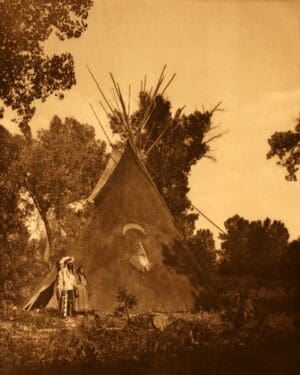
Apsaroke medicine tipi
$18.95 – $120.95 -
Sale!

Apsaroke war group
$18.95 – $120.95 -
Sale!

Apsaroke war-chief
$30.95 – $173.95 -
Sale!

Autumn – Apsaroke
$18.95 – $120.95 -
Sale!

Bread – Apsaroke
$30.95 – $173.95 -
Sale!

Bull Chief – Apsaroke
$30.95 – $173.95 -
Sale!

Chief and his staff – Apsaroke
$18.95 – $120.95 -
Sale!

Coups Well-Known – Apsaroke
$18.95 – $120.95 -
Sale!

Fish Shows – Apsaroke
$30.95 – $173.95

